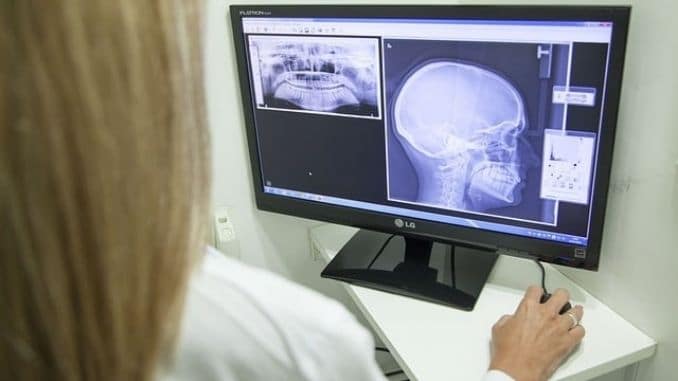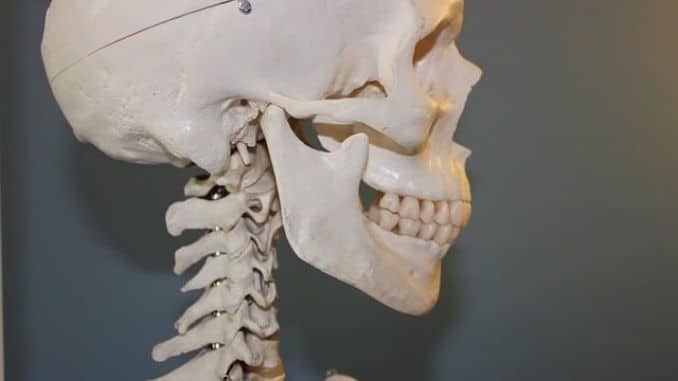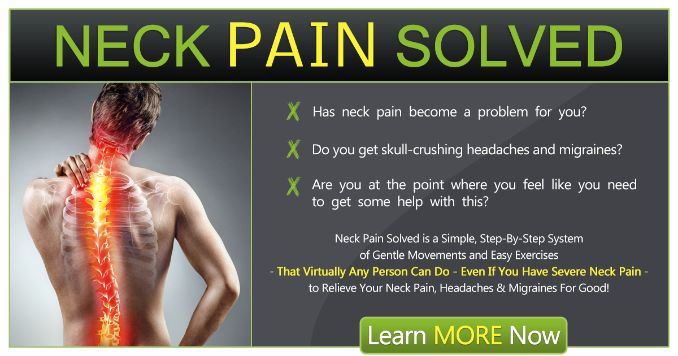
Tessa was worried. This was the third morning in a week she’d woken up with a stiff jaw. This morning, it was so stiff that, for a moment, she was concerned she wouldn’t be able to open her mouth at all.
Fortunately, after working it for a few minutes, it was OK, but the rest of the day, it bothered her.
Would there come a morning when her jaw would remain locked closed?
The National Institute of Dental and Craniofacial Research estimates that about 10 million Americans are affected by jaw joint and muscle disorders, commonly called “TMJ” or “TMJD” (temporomandibular joint and muscle disorders).
For most people, the condition doesn’t signal a serious problem, and symptoms are usually temporary but, for others, the condition can create chronic discomfort and pain.
If you suffer from frequent joint pain and/or stiffness, there are natural and home remedies that can help.
What Is TMJ?
The temporomandibular joint connects the lower jaw (mandible) to the upper jaw (maxilla) in front of the ear structure. The rounded part of the mandible sits against an indentation in the skull, with a disc-like structure of bone and cartilage between them to keep the joint moving smoothly.
Various ligaments in the head and neck hold the joint together, and several muscles are connected to those ligaments to help the jaw move. The joint moves in two different ways.
It moves like a hinge on a door, the jaw opens and closes the mouth. Alternatively, with a sliding motion, the jaw moves down and forward, then back, or from side to side.
These two motions help you move the jaw in all the ways you need to as you go about your daily life chewing, talking, yawning, singing and wiggling your ears. The fact that the jaw joint moves in these ways also makes it different and more complex than most other joints in the body.
TMJ disorders occur when something goes wrong with the jaw joint itself or the ligaments and muscles that surround it. These disorders are typically separated into the following three categories:
- Muscle-oriented: Pain and stiffness in the jaw come from inflamed and tight muscles that control jaw function.
- Joint-oriented: Pain or movement difficulties come from issues with the joint itself — perhaps a displaced disc, dislocated jaw or other injuries to the joint.
- Arthritis-oriented: Arthritis causes degeneration in the joint and the cartilage that cushions it.
An individual may have one or more of these conditions at the same time. Whatever is causing the issue, common symptoms include the following:
- Pain in and around the ear
- Jaw pain or soreness that is more prevalent in the morning or late afternoon
- Jaw pain when chewing, biting or yawning
- Jaw muscle stiffness
- Limited movement or locking of the jaw
- Clicking, popping or grating in the jaw joint when opening or closing the mouth
- A change in the way the upper and lower teeth fit together
- Headaches or neck aches
- Tenderness in the jaw or jaw muscles
- Difficulty opening and closing the mouth
- Sensitive teeth
Statistics show that TMJ affects more than twice as many women as men, although scientists aren’t sure why.
What Causes TMJ?
There are a variety of potential causes of TMJ. They include the following:
- Injury or trauma: The joint is damaged by an injury or impact. Possible causes include a car accident, sports injury or blow to the jaw.
- Arthritis: The joint’s cartilage is damaged by arthritis. This is more common as people get older or in those that have arthritis in their families.
- Disc problems: The disc erodes or moves out of its proper alignment, no longer providing proper cushioning to the joint.
- Grinding or clenching the teeth: Teeth grinding or clenching during sleep puts stress on the joint and the muscles around it, resulting in pain and stiffness.
- Misaligned teeth: Teeth that don’t line up as they should between the top and bottom rows can cause TMJ over time as they work against one another.
- Bad posture: If you sit or stand with your head forward a lot, you put extra strain on your head, face and neck muscles. That strain, over time, can lead to TMJ.
- Infections: An infection in the jaw joint can lead to symptoms of TMJ.
- Stress: Stress can cause muscle tension in the jaw, which can lead to pain and stiffness.
Sometimes, individuals may have more than one cause affecting the joint — arthritis and stress, for example, or bad posture and teeth grinding. Examine your lifestyle, check with your dentist and keep a diary of your symptoms to pinpoint what may be causing your jaw pain. Once you have the answer, it will help you choose effective treatments.
What Is Lockjaw?
Lockjaw occurs when there is a pain, swelling and muscle spasms around the jaw, leaving you unable to open it or shut it temporarily. There are two types of lockjaw, caused by two different things:
- Tetanus infection: This is a more serious but rare type of lockjaw caused by an untreated tetanus infection. One of the first symptoms is stiffness in the jaw and neck muscles. The bacteria that cause tetanus are found in soil, manure, and dust. They infect humans by entering through cuts or puncture wounds, usually because of injuries with contaminated objects or because of animal or bug bites. The risk of infection increases if the wound remains dirty. Staying up to date on your tetanus shots prevents this problem.
- TMJ: This is a less serious but more common form of lockjaw and is caused by stiff muscles, inflammation or deformed joints that aren’t functioning properly. The muscles can go into spasm, making it near impossible to open your mouth.
The most common reasons that TMJ may develop into a locked jaw include the following:
- Muscle fatigue: Overuse of the jaw joint, such as that which occurs with excessive gum chewing or nail biting, can gradually shorten and tighten the jaw muscles. Stress and repeated clenching of the jaw or teeth grinding can also result in jaw muscles that go into spasm.
- Joint problems: If your jaw clicks or pops regularly, there may be mechanical issues in the joint that can lead to muscle inflammation and spasm.
- Jaw injury: If you suffered a recent injury to the jaw, and it’s inflamed, swollen up, bruised or severely damaged, lockjaw can result.
- Cancer therapies: Radiation to address head and neck cancer sometimes affects the jaw muscles so that they become less flexible.
Treatment for lockjaw usually depends on what’s causing the symptoms. Doctors and dentists typically devise a treatment plan that includes exercises, anti-inflammatory medications or injections and physical therapy to help the jaw recover normal movement gradually.
The important thing to know is that TMJ lockjaw is usually not a serious problem and can be addressed with conservative treatments such as those listed below. Making healthy choices for your jaw can also help prevent lockjaw.
Only very rarely is surgery necessary and usually as a last resort. In fact, recent research has suggested that jaw surgery should be avoided whenever possible as the outcomes have not shown to be consistently beneficial.
Lifestyle Changes and Supplements to Ease TMJ Symptoms
If you’re experiencing any of the symptoms of TMJ, it’s wise to adopt lifestyle changes that can help. These include:
- Eating soft foods
- Applying ice packs as needed to reduce swelling and inflammation
- Applying heat when muscles seem tight and stiff
- Using over-the-counter pain relievers when needed
- Avoiding extreme jaw movements, such as those associated with gum chewing
- Improve your posture — stand up straight so that your head, neck, and spine are in proper alignment
- Practicing some sort of stress-relieving activity each day, including deep breathing, meditation, journaling, walking and taking warm baths
- Using self-massage or other massage treatments around the jaw to loosen up the muscles — gently massage the jaw and temple muscles in a circular motion while opening and closing the jaw slowly for about 30 seconds every four to six hours
- Using a mouth guard or stabilization splint overnight to help reduce teeth grinding and relieve pressure on the jaw joint and muscles
- Using gentle stretching and relaxing exercises to increase jaw movement ― examples below
There are some natural supplements too that can help reduce the inflammation and pain associated with TMJ. Always check with your doctor first:
- Glucosamine: Helps rebuild cartilage in the joint, which may improve range of motion. It’s particularly helpful in those with arthritis.
- MSM: Helps reduce muscle spasms and inflammation.
- Fish oil: Can help reduce inflammation.
- Turmeric: Another potent anti-inflammatory agent. It has been found in studies to help improve pain, swelling, and inflammation.
- Calcium: Supports optimal bone health in the joint.
- Magnesium: Necessary for muscles to relax.
- B vitamins: Help relieve stress. Make sure you’re getting the recommended daily allowance.
- Cramp bark: Can help reduce muscle spasms — consider this one when your jaw muscles are stiff. Use on the skin only — do not take internally.
- Kava: Can help you relax during a stressful period. It also helps tight muscles to loosen. Try a standardized product containing 70mg of the active compounds called “kavalactones” up to three times daily or try kava tea. This herb may make you drowsy.
- Valerian: Another calming herb that can reduce the effects of stress. If you’re going through a stressful time in your life and your jaw is acting up, try 300mg, up to three times daily or try valerian tea. This herb may cause drowsiness.
Jaw Exercises and Stretches That Help Prevent Lockjaw and Ease TMJ Symptoms
In addition to the recommendations above, it may also help to perform the following exercises and stretches regularly to increase jaw mobility and healing.
According to one study, therapeutic jaw exercises provided earlier recovery of jaw function than mouth guards or splints, particularly in cases where the disc had been displaced.
Jaw Stretches
Below are several exercises you can use to maintain proper TMJ function and ease tight jaw muscles:
- Jaw-opening exercise: Open and close your mouth slowly a few times as a warmup. Then, while opening, place your fingers on the top of your front four bottom teeth and pull down gently until you feel a slight discomfort at the side of your jaw. Your mouth should be open wide. Hold for 30 seconds, then repeat three times, gradually working your way up to 12 times.
- Smile stretch: Smile as widely as you can without feeling pain. While smiling, slowly open the jaw for an additional 2 inches. Inhale deeply, then exhale while relaxing the smile. Repeat up to 10 times.
- Chin tucks: Stand with your shoulders back and chest up. Pull your chin straight back, creating a double chin. Hold for 5 to 10 seconds and repeat up to 10 times.
- Yoga neck stretch: Neck stretches can help ease jaw tension too. For this one, cup the base of your skull at the back of your head with your right hand. Sit up tall and lengthen the neck. Then, reach your left arm straight out to the side and turn your head to the left, without letting it tip forward. Hold for three breaths, then repeat on the other side.
Jaw Exercises
These exercises should be performed only when your muscles are not in pain. Exercising painful muscles will only make them worse. When you’re in pain, stick to the stretches listed above. When the pain eases, try these exercises to keep your jaw muscles strong:
- Thumb under the chin: Place your thumb under your chin, then open your mouth slowly while applying gentle pressure against the movement with your finger. Hold open for 3 to 6 seconds, working the muscles, and then relax. Repeat three to five times.
- Wiggle the jaw: Place an object like a pencil between your teeth. Move your jaw gently over the object from one side to the other several times. If this is easy, use a thicker object like a marker. Once you’ve finished going back and forth, move the jaw forward and back by moving the lower teeth forward until they’re in front of your upper teeth. Repeat several times, then with a thicker object.
- Contract-relax jaw: Cross your thumb and index finger so that your thumb pushes up against your top teeth, and your index finger pushes down against your bottom teeth. Open your jaw as wide as you can and use your fingers to hold it in this position. Now, push your teeth against your fingers gently as if you were going to close your jaw but use your fingers against the pressure to keep it open. You should feel the muscles contracting. Hold for 10 seconds, then relax.
If you can, open the jaw even wider, then perform the contraction again. Repeat the held contraction and jaw opening three times. Always avoid pain. This stretch can help you gradually open your jaw more widely.
Combined Jaw Exercises
Close your mouth with your teeth touching. Do not clench. Rest the tip of your tongue on the roof of your mouth, just behind your front teeth. Run the tip back toward your soft palate at the back of your mouth as far as it will go without separating the teeth. Hold the tongue in this position while slowly opening your mouth until you feel the tongue being pulled away. Do not open any further, but stay in this position for 5 seconds, and then relax. You should feel the jaw muscles engage.
Neck pain can be linked with pain from TMJ. For your guide to eliminating neck pain, check out Neck Pain Solved, here!





